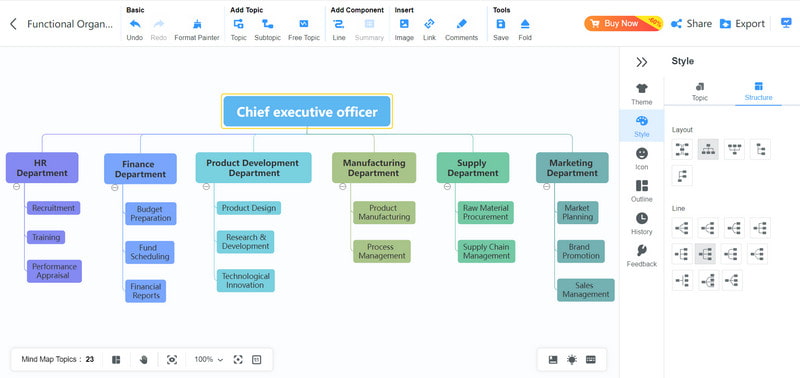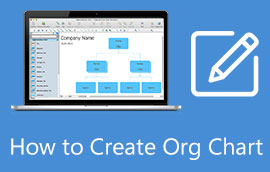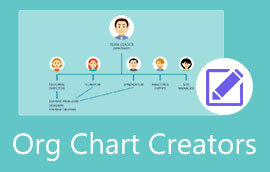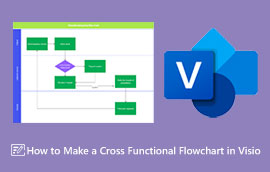Discover the Full Information of the Functional Organizational Structure
A functional organizational structure is a common type of business structure. It focuses on dividing the company into departments based on areas of specialization, and each department has its separate tasks and goals. If you are a functional manager or a team leader, applying a functional organizational structure to your team can be very beneficial to the success of the team and even the entire corporation. Would you like to learn more about it? Then, read on. This article will cover the four aspects of the organization: meaning, advantages, main features, and examples. Finally, we will provide you with one of the best tools for creating a functional organizational chart. So, let’s get started!

- Part 1. What is the Functional Organizational Structure
- Part 2. Advantages of Functional Organizational Structure
- Part 3. Main Features of Functional Organizational Structure
- Part 4. Examples of Functional Organizational Structure
- Part 5. Best Tool for Creating a Functional Organizational Structure Chart
- Part 6. FAQs
Part 1. What is the Functional Organizational Structure
The functional organizational structure is a form of organizational structure based on similarities in functions, tasks, and areas of expertise. In this structure, the organization is divided into different functional departments, each responsible for one or more functions. For example, a manufacturing company may have production, marketing, and sales departments. Moreover, each department has its leader, who reports to a higher-level leader and eventually to the chief executive officer.
Tasks, responsibilities, and authority inside these departments are clearly divided to ensure that work runs smoothly and the organizational goals are achieved. This type of organizational structure helps keep the business running smoothly and efficiently. Therefore, it is common in large corporations like Amazon, Apple, etc.
Part 2. Advantages of Functional Organizational Structure
Adopting a functional organizational structure in your business has many benefits, so let’s list them in detail.
• Clear responsibilities.
Each department has a clear scope of responsibilities, which enables employees to understand their work tasks. If there are any problems, employees know who to report them to, and managers know who they are responsible for so everyone can work more effectively. That is more like making a family tree that helps you understand the whole family members.
• Specialized division of labor.
Similar work and tasks are assigned to the same department so that employees in each department can focus on their specific functional areas. This helps improve their work efficiency and professional skills in the fields they are good at.
• Convenient management.
Each department has clear goals and responsibilities, which makes it easier for management to monitor and evaluate each department’s work performance. Thus, it can ensure that the departments operate at high speed according to organizational objectives.
• Full utilization of resources.
Each department focuses on its respective functions. So, the equipment, technology, and human resources can be used more effectively. This centralized use of resources helps reduce waste and improve overall operational efficiency.
• Expert-level functional skills.
Each functional department is usually led by experts with rich professional knowledge and experience. Under their leadership, the organization can develop professional skills in depth, contributing to its professionalism and competitiveness in the field.
Part 3. Main Features of Functional Organizational Structure
There are some main features of functional organizational structure, including the following:
• High organizational system stability.
The functional organizational structure emphasizes the professional division of labor and centralized management. Thus, each manager belongs to a functional organization and specializes in a particular functional work, enhancing the stability of the entire organizational system.
• Highly centralized management power.
The functional organizational structure usually has a centralized management power system, and the decision-making power of enterprise production and operation is concentrated in the top leadership, mainly senior managers.
• Highly specialized division of labor management.
Management agencies and personnel at all levels implement highly specialized divisions of labor. They are divided according to their functions, and each performs certain management functions, such as production, sales, finance, human resources, etc.
• Clear and top-down hierarchical structure.
The functional organizational structure has a clear, top-down hierarchy, and most have a senior management team supervising the company.
Part 4. Examples of Functional Organizational Structure
The functional organizational structure organizes labor division according to function. It divides businesses and people with the same function and sets up corresponding management departments and positions. The following is an example of electronic products company with a functional organizational structure.
Check and edit the chart of company’s functional organizational structure in MindOnMap here.

• Senior management: Chief executive officer.
• Functional departments:
1. HR Department: This department is responsible for human resource management, such as recruitment, training, performance appraisal, etc.
2. Finance Department: This department is responsible for financial management, such as budget preparation, fund scheduling, financial reports, etc.
3. Product Development Department: This department is responsible for product design, research and development, technological innovation, etc.
4. Manufacturing Department: This department is responsible for product manufacturing, process management, etc.
5. Supply Department: This department is responsible for raw material procurement, supply chain management, etc.
6. Marketing Department: This department is responsible for market planning, brand promotion, sales management, etc.
In this example of functional organizational structure, each function department focuses on its specific business area and supports the others, improving the company’s efficiency and specialization. This structure makes it easy to manage large-scale operations.
Part 5. Best Tool for Creating a Functional Organizational Structure Chart

MindOnMap is one of the best tools for creating a functional organizational structure chart. It is also one of the best tools for creating a functional organizational chart for free. As you can see, it can help you easily create a clear and concise functional organization chart. It has a simple but intuitive interface allows even first-time users to get started quickly.
In addition, you are provided with various chart types and themes so that you can freely choose the type of chart you want to create and then let your creativity run wild. It also has an automatic saving function and a history function to prevent you from losing your creations. It is compatible with multiple platforms, such as Windows and Mac, and can be used online without downloading. If you need to create functional organization charts or other types of charts, try MindOnMap, it will never let you down!
Part 6. FAQs
1. What are the 4 types of organizational structure?
The four main types of organizational structure are functional, divisional, matrix, and flatarchy.
2. What is one problem with the functional structure?
One problem with the functional structure is the weak connection between departments. Each department focuses on its functions and lacks cooperation and communication with other departments, thus affecting the entire organization’s efficiency.
3. What is functional hierarchy?
Functional hierarchy is an organizational method that involves multiple levels or tiers of hierarchy. It achieves effective management and execution of complex systems or tasks through functional layering.
Conclusion
This article mainly introduces four aspects of functional organizational structure and recommends a great tool, MindOnMap, to create a functional organizational chart by sharing our self-made charts. By the end of this article, you must understand what functional organization structure is and what it is all about. So, if you found this article helpful, please don’t forget to give us a like and leave a comment in the comments section!










